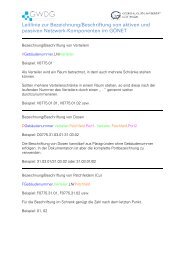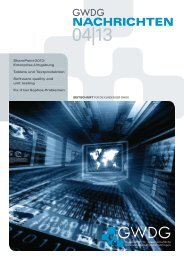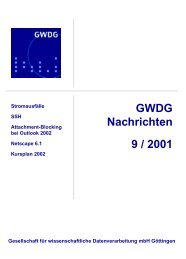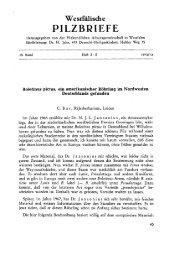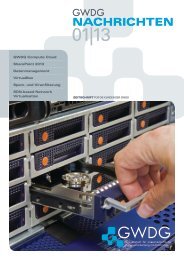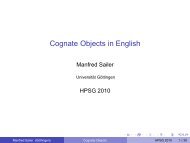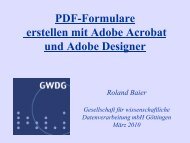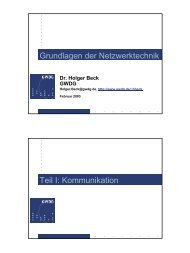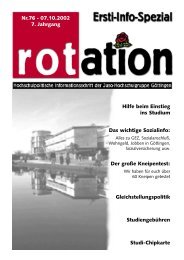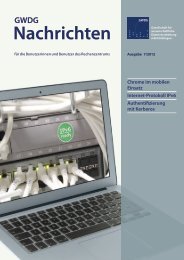Forschung und wissenschaftliches Rechnen - Beiträge zum - GWDG
Forschung und wissenschaftliches Rechnen - Beiträge zum - GWDG
Forschung und wissenschaftliches Rechnen - Beiträge zum - GWDG
Erfolgreiche ePaper selbst erstellen
Machen Sie aus Ihren PDF Publikationen ein blätterbares Flipbook mit unserer einzigartigen Google optimierten e-Paper Software.
world’s languages available to a large audience, including interested nonlinguists<br />
as well as linguists unfamiliar with the specialized literature on<br />
particular ‘exotic’ languages. However, the printed maps allow for only one<br />
unchangeable visualization of the data. To allow for a more flexible usage<br />
of the information supplied in the atlas, The Interactive Reference Tool was<br />
developed.<br />
2. The Interactive Reference Tool<br />
The Interactive Reference Tool (IRT, available on CD-ROM with the<br />
published atlas) has three main functions: customizing the display of the<br />
maps, providing complete reference to the languages displayed, and<br />
supplying open queries throughout all the data available. All these functions<br />
are implemented in an intuitively <strong>und</strong>erstandable way, so that even nonsophisticated<br />
users and non-linguists will be able to use the IRT, without<br />
much effort or training. (An inspection of the ‘guided tour’, as supplied<br />
with the program, should be sufficient to <strong>und</strong>erstand the majority of its<br />
functions.)<br />
First, the IRT allows the user to view the maps (as supplied in the printed<br />
atlas) in a variety of different forms. The interactive maps can be zoomed<br />
and panned, dot colors and shapes can be customized, and various<br />
geographic properties (like rivers, country names, topology, etc.) can be<br />
shown. Missing information based on the user’s own data can be added<br />
through an import function and customized maps can be saved, printed and<br />
exported for usage in publications or presentations. Further, for each dot on<br />
the interactive maps, the corresponding language name is shown with the<br />
‘mouse-over’ effect, and with a click on the dot a language profile (see<br />
below) appears in a separate window. Additionally, the different types of<br />
languages, as distinguished on a particular map, can be grouped. For<br />
example, a map showing five different types of languages can be<br />
transformed at will by combining any subgroup of these five types into one<br />
class, thus allowing the user to inspect the geographical distribution of<br />
overarching groups of characteristics.<br />
Second, the IRT contains additional information on all 2,560 languages<br />
included in the atlas. There is information on genealogical classification,<br />
alternative names, geographical location and more than 6,700 references to<br />
the literature used. This information is summarized in the language profile<br />
of a particular language, together with a list of all maps in which the<br />
language in question appears and the type of this language in this map.<br />
Moreover, for almost all information points (viz. each combination of<br />
language, map, and language-type) there is additional information in the<br />
form of an exact bibliographical reference (down to the page numbers from<br />
which the information is taken), and many points additionally contain<br />
77



